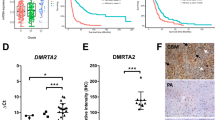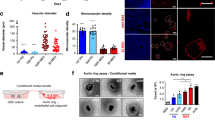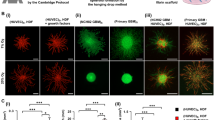Abstract
Glioblastoma is a highly angiogenetic malignancy, the neoformed vessels of which are thought to arise by sprouting of pre-existing brain capillaries. The recent demonstration that a population of glioblastoma stem-like cells (GSCs) maintains glioblastomas1,2 indicates that the progeny of these cells may not be confined to the neural lineage3. Normal neural stem cells are able to differentiate into functional endothelial cells4. The connection between neural stem cells and the endothelial compartment seems to be critical in glioblastoma, where cancer stem cells closely interact with the vascular niche and promote angiogenesis through the release of vascular endothelial growth factor (VEGF) and stromal-derived factor 1 (refs 5–9). Here we show that a variable number (range 20–90%, mean 60.7%) of endothelial cells in glioblastoma carry the same genomic alteration as tumour cells, indicating that a significant portion of the vascular endothelium has a neoplastic origin. The vascular endothelium contained a subset of tumorigenic cells that produced highly vascularized anaplastic tumours with areas of vasculogenic mimicry in immunocompromised mice. In vitro culture of GSCs in endothelial conditions generated progeny with phenotypic and functional features of endothelial cells. Likewise, orthotopic or subcutaneous injection of GSCs in immunocompromised mice produced tumour xenografts, the vessels of which were primarily composed of human endothelial cells. Selective targeting of endothelial cells generated by GSCs in mouse xenografts resulted in tumour reduction and degeneration, indicating the functional relevance of the GSC-derived endothelial vessels. These findings describe a new mechanism for tumour vasculogenesis and may explain the presence of cancer-derived endothelial-like cells in several malignancies.
This is a preview of subscription content, access via your institution
Access options
Subscribe to this journal
Receive 51 print issues and online access
$199.00 per year
only $3.90 per issue
Buy this article
- Purchase on SpringerLink
- Instant access to full article PDF
Prices may be subject to local taxes which are calculated during checkout




Similar content being viewed by others
Accession codes
Primary accessions
ArrayExpress
Data deposits
Data have been deposited at the European Bioinformatics Institute (http://www.ebi.ac.uk/arrayexpress/) under accession number E-MEXP-2891.
References
Singh, S. K. et al. Identification of human brain tumour initiating cells. Nature 432, 396–401 (2004)
Vescovi, A. L., Galli, R. & Reynolds, B. A. Brain tumour stem cells. Nature Rev. Cancer 6, 425–436 (2006)
Ricci-Vitiani, L. et al. Mesenchymal differentiation of glioblastoma stem cells. Cell Death Differ. 15, 1491–1498 (2008)
Wurmser, A. E. et al. Cell fusion-independent differentiation of neural stem cells to the endothelial lineage. Nature 430, 350–356 (2004)
Bao, S. et al. Stem cell-like glioma cells promote tumor angiogenesis through vascular endothelial growth factor. Cancer Res. 66, 7843–7848 (2006)
Folkins, C. et al. Glioma tumor stem-like cells promote tumor angiogenesis and vasculogenesis via vascular endothelial growth factor and stromal-derived factor 1. Cancer Res. 69, 7243–7251 (2009)
Calabrese, C. et al. A perivascular niche for brain tumor stem cells. Cancer Cell 11, 69–82 (2007)
Gilbertson, R. J. & Rich, J. N. Making a tumour’s bed: glioblastoma stem cells and the vascular niche. Nature Rev. Cancer 7, 733–736 (2007)
Lathia, J. D. et al. Integrin α6 regulates glioblastoma stem cells. Cell Stem Cell 6, 421–432 (2010)
Hida, K. et al. Tumor-associated endothelial cells with cytogenetic abnormalities. Cancer Res. 64, 8249–8255 (2004)
Streubel, B. et al. Lymphoma-specific genetic aberrations in microvascular endothelial cells in B-cell lymphomas. N. Engl. J. Med. 351, 250–259 (2004)
Pezzolo, A. et al. Tumor origin of endothelial cells in human neuroblastoma. J. Clin. Oncol. 25, 376–383 (2007)
Singh, S. K. et al. Identification of a cancer stem cell in human brain tumors. Cancer Res. 63, 5821–5828 (2003)
Galli, R. et al. Isolation and characterization of tumorigenic, stem-like neural precursors from human glioblastoma. Cancer Res. 64, 7011–7021 (2004)
De Palma, M., Venneri, M. A. & Naldini, L. In vivo targeting of tumor endothelial cells by systemic delivery of lentiviral vectors. Hum. Gene Ther. 14, 1193–1206 (2003)
De Palma, M., Venneri, M. A., Roca, C. & Naldini, L. Targeting exogenous genes to tumor angiogenesis by transplantation of genetically modified hematopoietic stem cells. Nature Med. 9, 789–795 (2003)
Hendrix, M. J., Seftor, E. A., Hess, A. R. & Seftor, R. E. Vasculogenic mimicry and tumour-cell plasticity: lessons from melanoma. Nature Rev. Cancer 3, 411–421 (2003)
Dome, B., Hendrix, M. J., Paku, S., Tovari, J. & Timar, J. Alternative vascularization mechanisms in cancer: pathology and therapeutic implications. Am. J. Pathol. 170, 1–15 (2007)
Maniotis, A. J. et al. Vascular channel formation by human melanoma cells in vivo and in vitro: vasculogenic mimicry. Am. J. Pathol. 155, 739–752 (1999)
Alvero, A. B. et al. Molecular phenotyping of human ovarian cancer stem cells unravels the mechanisms for repair and chemoresistance. Cell Cycle 8, 158–166 (2009)
Eramo, A. et al. Chemotherapy resistance of glioblastoma stem cells. Cell Death Differ. 13, 1238–1241 (2006)
Pallini, R. et al. Cancer stem cell analysis and clinical outcome in patients with glioblastoma multiforme. Clin. Cancer Res. 14, 8205–8212 (2008)
Ricci-Vitiani, L. et al. Absence of caspase 8 and high expression of PED protect primitive neural cells from cell death. J. Exp. Med. 200, 1257–1266 (2004)
Acknowledgements
We thank L. Naldini for providing the lentiviral vectors and S. Forte for gene array data elaboration. This work was supported by grants from Associazione Italiana per la Ricerca sul Cancro.
Author information
Authors and Affiliations
Contributions
L.R.-V. and R.P. performed most of the experiments and coordinated the project; M.B. performed cell sorting and flow cytometric analysis; M.T. and G.S. detected and characterized human endothelial cells in mouse xenografts; G.I. and E.A.P. developed the functional assays of the endothelial cell cultures; G.M. recruited the patients and performed surgery; T.C. and L.M.L. were involved in pathology assessment and detection of genomic aberration in endothelial cells; R.D.M. conceived the study and wrote the paper.
Corresponding authors
Ethics declarations
Competing interests
The authors declare no competing financial interests.
Supplementary information
Supplementary Information
This file contains Supplementary Tables 1- 2 and Supplementary Figures 1-12 with legends. (PDF 3254 kb)
Rights and permissions
About this article
Cite this article
Ricci-Vitiani, L., Pallini, R., Biffoni, M. et al. Tumour vascularization via endothelial differentiation of glioblastoma stem-like cells. Nature 468, 824–828 (2010). https://doi.org/10.1038/nature09557
Received:
Accepted:
Published:
Issue Date:
DOI: https://doi.org/10.1038/nature09557



